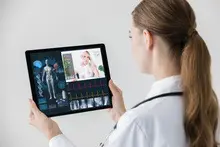Does Telemedicine Put Patients at Risk of Medical Mistakes?

New York City, NY – Top attorney, handles medical malpractice, doctor errors, medical mistakes, MTA, bus accidents, wrongful death, airline injuries & death, and construction cases. Attorney Jonathan C. Reiter consistently delivers results.
When you’re sick, trekking to the doctor’s office, dealing with traffic, and then sitting in the waiting room can be a chore — and often one that makes your symptoms worse. For people who live in rural areas, seeing a doctor can even mean driving for an hour or more. Furthermore, visiting a doctor’s office also puts you at risk of catching other illnesses from the people around you.
Telemedicine, also sometimes called e-medicine or “direct to consumer” (DTC) medicine, aims to address these problems. By using smartphones and remote conferencing technology, the process connects patients live with doctors through a computer screen or smartphone app. Through a computer or smartphone screen, patients describe their symptoms to the doctor, who will then decide the best way to proceed with treatment. At that point, the patient may receive a diagnosis over the phone or computer.
With telemedicine, doctors can even prescribe medication remotely, without ever physically examining the patient. Doctors can also use their own computer system to electronically transmit prescriptions to the pharmacy, where a patient can later pick them up.
In most cases, telemedicine is designed for patients to receive treatment for relatively common ailments, such as the flu, urinary tract infections and strep throat. Whereas patients in the past might have needed to see a doctor at an urgent care or walk-in clinic, telemedicine means that patients can receive immediate access to medical care without leaving the house.
However, some experts have raised concerns about telemedicine. If a doctor never physically examines a patient, will they truly give an accurate diagnosis? Telemedicine relies almost entirely on the patient describing their symptoms. This practice has caused some to question whether the technology is safe.
Potential Risks of Telemedicine
One of the main risks of telemedicine is misdiagnosis. The majority of people seeking medical attention from a healthcare professional do not have a medical field background, which means they might not always accurately describe or identify their symptoms.
In a study published in the Journal of the American Medical Association Dermatology, researchers assessed the accuracy of telemedicine in the context of dermatological conditions. In the study, researchers noted that 1.25 million people used telemedicine sites or apps in 2015 alone.
The study, which analyzed 62 doctor and patient interactions across 16 telemedicine platforms, found that doctors sometimes prescribed treatments that went against the standard of care under established medical guidelines.
In the same study, researchers also found that doctors missed dermatological conditions and failed to diagnose problems. “[R]elatively little is known about the quality of these services. A recent study assessing DTC telemedicine consultations for primary care conditions revealed a lack of appropriate diagnostic testing and poor antibiotic stewardship. Reviews of teledermatology services showed failures to collect key medical history and raised concerns about the use of international physicians and advertising prominently featuring easily obtained prescriptions.”
Some of the problems the study identified include:
- Lack of clinician choice – Researchers stated, “Patient choice of their treating physician is part of our medical code of ethics, and we were surprised that these websites with multiple clinicians on staff assigned a clinician without patient choice in most encounters.”
- Failure to identify clinician credentials – The study also pointed out that “transparency about licensing and credentials is inherent in patient choice and informed consent, and most services failed to provide licensure or board certification information during encounters. Despite claims that they were not providing health care services, we believe that [two] DTC telemedicine websites headquartered in California but using foreign clinicians were engaged in the practice of medicine without a state license, as they clearly provided diagnoses and treatment recommendations.”
- Failure to obtain patient health history – The study also noted that “many diagnoses were proffered without reasonable attempts to ask basic medical history follow-up questions, treatment recommendations sometimes contradicted evidence-based guidelines…”
- Medication mistakes – Researchers stated, “[P]rescriptions frequently lacked basic disclosure of adverse effects, risks, or pregnancy warnings.”
- Accuracy problems – The study also found problems with the telemedicine sites’ failure to confirm basic patient information. “No…telemedicine websites attempted to confirm the identity of patients or raised doubts about the authenticity of photographs.”
Researchers concluded that telemedicine can be a positive addition to existing health care models, but that it’s best if the technology is connected to the patient’s regional or local health care system.
As the researchers stated, “We believe that DTC telemedicine can be used effectively, but it is best performed by physicians and team members who are part of practices or regional systems in which patients already receive care. This allows telemedicine clinicians to view a patient’s existing medical records, communicate with existing health care team members, provide in-person follow-up when needed, and be accountable for the care they deliver.”
While telemedicine possibly has the potential to make health care more accessible to more people, the convenience shouldn’t come at the expense of safety. Anyone who has been injured due to a medical mistake or doctor’s misdiagnosis through a telemedicine system may be entitled to compensation for their injury. If you are looking for the best medical malpractice lawyer in the Bronx, call (212)-736-0979 and speak with New York Attorney Jonathan C. Reiter today.
Bronx Medical Malpractice Attorney Jonathan C. Reiter
(T): 212-736-0979
Sources:
***ATTORNEY ADVERTISING***
Prior results cannot and do not guarantee or predict a similar outcome with respect to any future case. Recoveries always depend upon the facts and circumstances of each case, the injuries suffered, damages incurred, and the responsibility of those involved.

